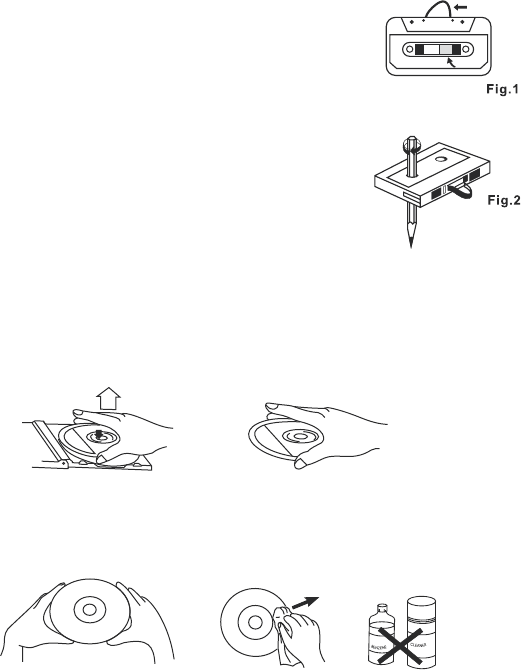
CASSETTE CARE
Two common causes of trouble experienced when using cassettes are:
1) Tape jamming-Leading to uneven speed in playback.
2) Tape entangling- the tape wraps itself around vital parts of the mechanism.
To reduce the likelihood of these problems occurring, the following precautions
should be observed:
Check that there are no loose layers of tape visible
through the cassette centre window (see Fig. 1).
Take up any loose layers, using a pencil or hexagonally
Barreled ballpoint pen, before inserting the cassette
into the machine (see Fig. 2).
If the cassette feels tight while performing operation
shown (see Fig. 2), the tape may be jamming due to
ridges formed in the winding of the tape (visible
through the centre window). These may be removed
in most cases, by fast winding of the cassette from
one end to the other and back again.
Use only well-known brands of tape. Avoid use of C-120 Cassettes. Furthermore, do not
expose cassettes to direct sunlight, dust or oil, and do not touch the tape surfaces.
COMPACT DISC CARE
To remove a disc from its storage case, press down on the centre of the case and lift the disc
out, holding it carefully by the edges.
Fingerprints and dust should be carefully wiped off the disc s recorded surface with a soft
cloth. Unlike conventional vinyl or shellac records, compact discs have no grooves to
collect dust and microscopic debris, so gently wiping with a soft cloth should remove most
particles. Wipe in a straight line from the inside to the outside of the disc. Small dust
particles and light stains will have absolutely no effect on sound reproduction quality.
Clean the disc periodically with a soft, lint-free, dry cloth. Never use detergents or abrasive
cleaners to clean the disc. If necessary, use a CD cleaning kit.
Never affix labels to the surface of compact discs or write on them, except very gently with
specialist CD-R Pens.
CARE OF THE CABINETS
You should care for the cabinet as you would care for any piece of fine furniture. When the
cabinet becomes dusty, wipe it with a soft, non-abrasive dusting cloth. If the cabinet
becomes smudged with finger prints, you may use any good quality commercial dusting
and polishing spray cleaner. However, avoid spraying the plastic or metal parts of this
system. We recommend that you spray the cleaner onto your dusting cloth not directly onto
the cabinet to avoid getting any of the spray on the plastic or metal parts.
9












